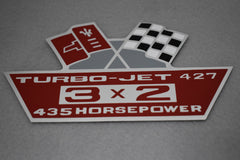A Brief History of the Iconic Corvette C3
Chevrolet Corvette C3 was introduced in 1967 and remained in production till 1982. Being an iconic car in its prime time, it was the third generation of the Corvette sports car. This particular iteration featured new interiors and body, the engines and chassis however were taken from the previous generations. Let’s take a look at the glorious history of the car.
The Early Years
Many auto experts argue that the design elements of the C3 Corvette resemble the second-run Mako Run II concept that was showcased in 1964. Corvette C3 from 1968 was offered as a convertible or coupe.
For the 1969 model, engine displacement increased from 327 to 350 cubic inches, with power figures remaining the same. Also, drivetrain options remained unaltered. The Sting Ray title from the C2 was revived for the 1969 C3 Corvette model. The exterior changes included reworked door handles, headlamp washers, and a black grille. As for the interiors, changes included redesigned door panels, standard headrests, reduction in the steering wheel’s diameter (allowing easier entry), and the ignition switch was shifted to the steering column. The year 1969 was special for the introduction of the ZL1 option. It boasted a 7.0 liter aluminum engine.
Growing Up
The 1970 model saw a lot of changes for the sports car. The size of the tailpipe was increased (its shape transformed from circular to rectangular). The seats also received a decent upgrade that was redesigned with leather upholstery and upgraded carpets. Tinted windows, 4-speed (wide ratio) manual transmission, and positraction rear axle now came as standard features. It was lauded by Corvette lovers.
For the model introduced in the subsequent year, the engine was down-tuned. This was done primarily to reduce the compression ratio to make it compatible with lower octane gasoline. An LS6 454 cubic inch, 425-hp big-block engine was available on the same year that could harness the prowess of automatic transmission. Interestingly, this was also the highest engine output at that time.
For the 1972 model, the LS5 big block engine 454 cubic inch engine received an upgradation to 270 horsepower. Thanks to the state's stricter emission standards, this engine was not available in California.
Major Changes
The year 1973 is regarded as a significant year for the Corvette C3, where it transitioned from a muscle car to a sports tourer. Riding quality significantly improved, and the engineers made a 40 percent reduction in the internal noise. Allowing zero changes to the chrome rear bumper, the front row now featured a lightweight energy-absorbing bumper to comply with the federal laws. L-82 engine replaced the LT-1 engine with a maximum power output of 250 horsepower.
Transitional Years
A catalytic converter was introduced in 1975 to comply with federal laws. Weight savings were made with the 1976 model, and in 1977, a few more changes were made.
On its 25th anniversary in 1978, the aerodynamics was significantly improved, and the rear window was replaced by a fastback design. To complement the center console, the instrument cluster was also revamped.
The early 80s saw the introduction of standard power windows, tilting/telescopic steering columns, and air conditioning. In the final chapter, a collector edition was offered with limited edition features.
Conclusion
That’s about it, and we hope you enjoyed the post. If you are looking for C3 Corvette rear wheel bearing assembly and other discontinued and rare parts for your classic Corvette car, The Spindle People will make all the possible attempts to find it for you. Visit the online store to know more.




